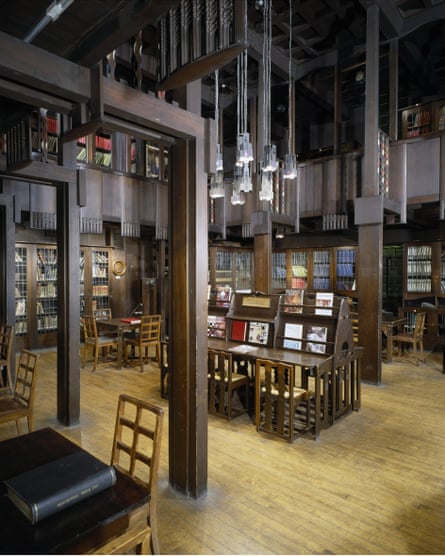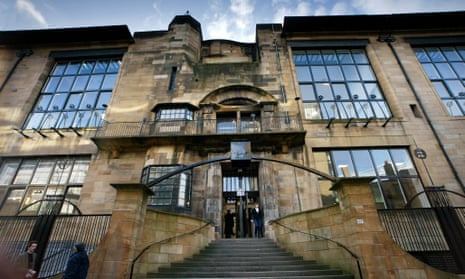The smoke has barely cleared over the blackened carcass of the Glasgow School of Art, which was gutted by a fire on Friday night, but the architecture world is already alight with debate about what should come next.
To many, Glasgow without Charles Rennie Mackintosh’s finest work is unthinkable: his masterpiece must be reconstructed stone by stone, no matter the cost. But the extent of the destruction from the fire, which appears to have left only the stone facades standing, have led others to call for a new building to take its place.
“From what I’ve seen, restoration is not an option,” argues Alan Dunlop, a Glasgow-based architect and alumnus of the Mack. “We’d be talking about replication, which is totally against what Mackintosh stood for. He was an innovator, working at the cutting edge. He would want to see a new school of art fit for the 21st century.”
Dunlop fears that replicating the building would risk “turning it into a museum piece”, with the needs of tourists put ahead of students.
“Before the first fire in 2014, the famous library had already become a museum,” he says. “The school used it for fundraising dinners, and students had to make an appointment if they wanted to go in. I argued then that we should make a new library fit for students’ needs, and I believe the same is true now for the whole building.”
He has called for an international design competition, with the stipulation that the shortlist should include a Scottish architect “as a serious entry, not just a token gesture to make up the numbers”. Mackintosh was in his 20s when he designed the first phase of the school, he adds, and there are young architects capable of creating something just as powerful now.
To many Mackintosh experts and conservation architects alike, Dunlop’s talk is anathema.
“I see no argument for why you wouldn’t rebuild the school of art as it was,” says Roger Billcliffe, author of a number of definitive books about Mackintosh. “It has been voted Britain’s most important building several times over, and we have all of the information needed to recreate every detail, following extensive laser surveys after the first fire. People are saying, ‘Let’s get a good modern architect instead,’ but we’ve already had one in theory, and we got that Steven Holl monstrosity across the road.”

Holl’s green-tinged glass extension of 2013 has been widely criticised, looming opposite the Mackintosh building with all the elegance of a discarded fridge. It won Private Eye’s Sir Hugh Casson award in 2014 for the worst new building of the year, and was damned as a “crude and insufferably arrogant essay in minimalist neo-modernism”.
Despite Mackintosh’s meticulous details and sophisticated spatial sequences, Billcliffe argues that the school of art would not be difficult to rebuild. He says that most of the conservation analysis has already been done, and that much of the replacement woodwork for the library had yet to be installed, and is safely stored in the carpenters’ workshops in Edinburgh. The Glasgow School of Art declined to comment.
“Compared to some of Mackintosh’s other buildings, there’s not a lot of fancy footwork in the art school,” he adds. “There were one or two set pieces, made of stone or metal – and who knows, they might have survived. After all, they managed to salvage most of the metal light fittings after the first fire.”
Careful excavation is crucial. Julian Harrap, the conservation architect behind the critically acclaimed rebirth of the Neues Museum in Berlin, who has years of experience dealing with fire-ravaged buildings, says the most important next step is sifting through whatever remains inside the charred shell.
“There will be piles of material lying at the bottom of the building that can be easily repaired and reused,” he says. “Think of Mackintosh’s metal work: every door had hinges, locks, push plates, the most fantastic material, which could still be there. There will be very big timber beams, too, which is a resource that can still be used, even in a different way.”

Harrap is emphatic that building an exact replica is not the right way forward. “It would be a disgrace to our profession,” he says. “The idea of knocking it down and building something entirely new is equally unacceptable. We have to tread this fragile middle ground. I believe the shell of the building can be retained, with a very simple interior, with memories of Mackintosh where they’re available. The position of the windows all related to internal volumes, so you already get a framework of the spaces that were once there.” He thinks the school should acquire the adjoining sites, which were also damaged by the fire, where additional facilities could be constructed “to satisfy the needs of a modern art school, rather than trying to shoehorn everything into the reconstructed shell”.
This is the approach Harrap took, with architect David Chipperfield, at the Neues Museum, combining immaculate restoration with visible scars of bomb damage and striking new additions – to widespread praise. If done well, it could be brilliant. If bodged, it could be another act of reckless “facadism”, an insult to Mackintosh by keeping his hollow stone mask as a redundant husk of history.
“The building is simply too special to do anything other than rebuild it,” says Tony Barton, chairman of Donald Insall Associates, the practice that led the restoration of Windsor Castle following a severe fire in 1992. “There is not one single technical reason why it cannot be fully restored. There are very few buildings in the world for which you can argue for total reconstruction, but this is one of them. It’s not just about the facade: Mackintosh designed every corner of the thing down to every last detail. Even the back stairs were beautiful.”
Some fragments may yet emerge from the ashes, if enough time is taken to sift through the site with forensic care. A pair of distinctive wrought iron finials still rise triumphantly above the burnt-out wreck, two floral orbs each crowned with a bird, standing as a defiant symbol on the horizon. “It’s as if Mackintosh is saying, ‘I haven’t brought to my knees yet,’” says Stuart Robertson, director of the Charles Rennie Mackintosh Society. “‘I’m still here, and I won’t be bulldozed that easily.’”

Comments (…)
Sign in or create your Guardian account to join the discussion